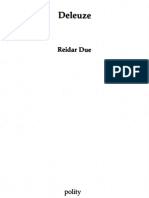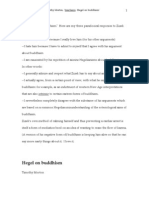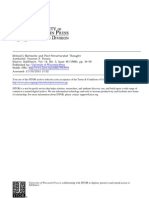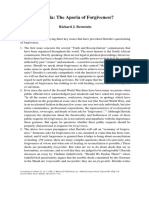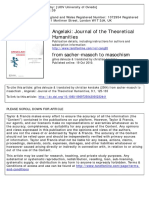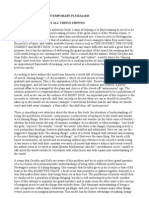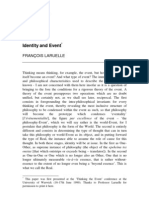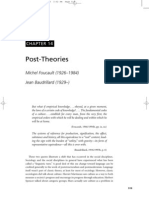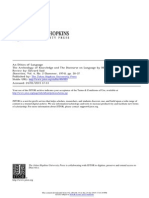Pearson Introduction To Deleuze
Pearson Introduction To Deleuze
Uploaded by
heryprasCopyright:
Available Formats
Pearson Introduction To Deleuze
Pearson Introduction To Deleuze
Uploaded by
heryprasOriginal Title
Copyright
Available Formats
Share this document
Did you find this document useful?
Is this content inappropriate?
Copyright:
Available Formats
Pearson Introduction To Deleuze
Pearson Introduction To Deleuze
Uploaded by
heryprasCopyright:
Available Formats
SubStance #114, Vol. 36, no.
3, 2007
1 Introduction to Deleuzes Lecture Course
Beyond the Human Condition:
An Introduction to
Deleuzes Lecture Course
1
Keith Ansell Pearson
Introduction
Deleuzes 1960 lecture course at lEcole Suprieure de Saint-Cloud on
chapter three of Bergsons Creative Evolution is of interest to us today for a
number of reasons. The course can be read in the light of Deleuzes attempt
from 1956 to 1966 to demonstrate Bergsons importance for philosophy
(what we might call the Bergsonian Revolution). But it also provides
a set of revealing insights into the development of Deleuzes own
philosophical project. Not only does it display Deleuzes tremendous
gifts as a pedagogue, it also contains in embryonic and germinal form
some of the essential modes of thought that characterize his contribution
in the development of philosophy in post-war France. My intention in
this introduction is not to provide a commentary on the lecture course.
Instead I want to illuminate two topics that occupy an important place
in the Bergsonian revolution and which inform and shape Deleuzes
interpretation of Bergson, both in the lecture course and in his published
writings on Bergson: Bergsons relation to Kant, and the endeavour to
think beyond the human condition.
Before examining these topics, however, let me note some significant
and revealing features of the lecture course. By the time of the lecture
course, Deleuzes main publications were his book on Hume published in
1953, an extraordinarily fresh and original study of empiricism and
subjectivity, and an article published in 1956 on the concept of difference
in Bergson.
2
In 1959-60 he had begun to give lecture courses on Nietzsche
as well as Bergson, and one of the most interesting aspects of the present
lecture course is that it shows there was a brief moment in post-war
thought when Bergson was posited alongside Nietzsche as an ally in the
overcoming of metaphysics. Bergson, Deleuze notes in the lecture of 28
March 1960, participates in the Nietzschean moment of philosophy. This
consists in the abolition of the intelligible world, an abolition that signals
the end of metaphysics (the division into real or true and apparent
Keith Ansell Pearson
SubStance #114, Vol. 36, no. 3, 2007
2
worlds), or what Nietzsche calls in Twilight of the Idols the moment of the
shortest shadow. However, there are some crucial differences: where
Nietzsche tells the history or story of how the true world finally
became a fable, which is also a story of the devaluation of the highest
values and the advent of nihilism, Bergson seeks to reorient metaphysics,
to bring science and philosophy into a new rapport, with the ultimate
aim of re-connecting human thought and existence to, as Deleuze puts it,
the universal consciousness of the Whole (le Tout). Perhaps the crucial
difference is that while the Nietzschean can only invert Platonism and
parody metaphysics, the Bergsonian has found a different path, one that
is able to articulate a philosophy of pure becoming that enables thought
to think beyond the human condition. As Deleuze points out in the lecture
course, for Bergson, metaphysics begins not with Plato but with Zeno.
3
As is well known, while Nietzsches thinking has assumed an
extraordinary importance for us today, Bergsons work has fallen into
serious neglect. The manner in which Deleuze is able to demonstrate
Bergsons importance for the future of philosophy the lecture course is
admirable in this regard shows the injustice of this neglect. Perhaps
the most significant feature of Deleuzes work on Bergson overall is its
ability to see with tremendous clarity, and to pinpoint with accuracy,
the significance of Bergsons project for philosophy. We see this in the
very opening of the lecture course, where Deleuze indicates precisely
where Bergsons importance lies, namely in the effort to radicalize the
post-Kantian project commenced by Solomon Maimon and J. G. Fichte:
the need to pass from a transcendental philosophy to a genetic one
(Deleuze spells out the details of this move at the beginning of his opening
lecture).
4
Exposing the myth of the given has, of course, been a
preoccupation of a great deal of twentieth-century philosophy, with
respect to both analytical and continental sources of thought. Deleuzes
lecture course focuses attention in large measure on the nature of
Bergsons singular contribution to this project. Neither the intellect nor
matter can be taken as given (today the polarity is cashed out as one of
mind and world);
5
rather, there is a need for a double genesis. It is
this conception of genesis that constitutes such an essential aspect of the
Bergsonian revolution. If successful, it means that we will be able to
enter into the Whole, or what Deleuze calls the universal consciousness
of Life.
While many may find such an effort nave in the wake of the linguistic
turn in philosophy, to say nothing of deconstruction, Deleuze never
appears to have seen it in these terms (and surely he was able to do so in
SubStance #114, Vol. 36, no. 3, 2007
3 Introduction to Deleuzes Lecture Course
the 1950s and 1960s). For Deleuze, Bergson is not, as the typical portrait
of him would have it, either an irrationalist or a nave realist. Indeed, the
significance of chapter three of Creative Evolution is that it is here that
Bergson demonstrates the startlingly original character of his resolution
of a truly core philosophical problem. In the lecture course, Deleuze aims
to show how chapter three of Creative Evolution works in relation to the
previous two chapters of the book and, moreover, that the problem it
addresses concerns the entirety of Bergsons thought and weighs on the
whole of his philosophical system (9 May 1960).
The Whole for Bergson is, in essence, universal mobility or the
immanence of becoming (movement and change). As such, it is never,
and can never be, given. Of course, this fact presents an extraordinary
challenge to our ingrained habits of thinking (as Nietzsche noted, do not
knowledge and becoming exclude one another by definition?).
Bergson is the thinker par excellence of open systems. In the lecture course
Deleuze stresses that the Whole enjoys neither interiority nor totality;
individuated forms of Life have a tendency towards closure but this is
never accomplished on account of Life. As Bergson puts it in Creative
Evolution, finality is external or it is nothing at all (CE, 27). In his lecture
course Deleuze fully appreciates the importance of this insight. Deleuze
continues this new way of thinking the Whole in his 1966 text, Bergsonism.
There he argues two things: (a) the Whole is only ever virtual and divides
itself by being acted out, and in the actual we only encounter an irreducible
pluralism; and (b) that the Whole is not given should meet with our
delight it is only our habitual confusion of time with space, and the
assimilation of time into space, that makes us think the Whole is given, if
only in the eyes of God (104). We could say: on the level of Life there is
only actualization and differentiation, which amount to a genuine
creation, but to make adequate sense of this we need to appeal to a
conception of the Whole, and what matters is the conception of the Whole
that we evince (for Bergson it is the lan vital conceived as a virtual
power; for Nietzsche it is the will to power conceived as a Vorform or pre-
form of life).
6
That Bergsons thinking orients itself around a philosophy of life is
not an incidental feature, but an absolutely fundamental aspect. It is
from the primacy that is to be accorded to Life that adequate conceptions
of the rest of philosophy can be developed, such as metaphysics,
epistemology, and ethics. One of the most interesting features of Deleuzes
lecture course is the suggestion that this is also the case for our concern
with history: if Life is to be conceived in terms of a principle of
Keith Ansell Pearson
SubStance #114, Vol. 36, no. 3, 2007
4
differentiation (Bergsons rendition of the principle of sufficient reason),
then is this not also valid for the domain of history? The move is a
significant one in Deleuzes eyes, since it explains why Bergson is never
doing a philosophy of history. Indeed, Deleuze claims in the course that
Bergson refrains from doing a philosophy of history in The Two Sources of
Morality and Religion precisely because of his appreciation of the open
character of Life: there can be no overarching category or notion that
would then allow thought to impose a teleology on history, be it Spirit or
Reason. As Deleuze notes in the course, The living is essentially a being
that has problems and resolves them at each instant (21 March 1960).
7
While this is valid for all forms of Life, it assumes a special particularity
in the case of humanity. In spite of the break with the philosophy of
history, and its attendant historicism for Deleuze contingency is the
norm of history
8
a story of freedom is still being posited: duration is the
condition of possibility of freedom and choice in Bergson, which contrasts
with relaxation where moments of time exist outside each other in an
un-synthesized manner. It is at this point in his lecture course that Deleuze
reveals that he has assimilated not only Bergson and Nietzsche, but also
Freud (who will also play an important role in the reading of Nietzsche
on memory and forgetting in Nietzsche et la philosophie of 1962). For Deleuze,
Bergson has the same idea as Freud with regard to freedom: the more past
there is, the more future a living system has, and hence more freedom.
Memory, then, is not simply of the past but primarily a function of
the future (21 March 1960).
9
If history cannot be approached through the imperial claims of a
philosophy of history, this does not mean, however, that we should take
Deleuze to be claiming that it is completely random or arbitrary or that
is without a subject: in Bergsons schema, as Deleuze conceives it, the
subject of history is the brain. At the end of the lecture course, Deleuze
ventures the claim that history exists because the human brain, by its
complexity, is a mechanism where the lan vital surpasses mechanism
itself. We know that there is much here that will become important for
the later Deleuze. In the course of the complex development of his
thinking, his Bergsonian-inspired insights get repeatedly reworked. It is
highly doubtful that the later Deleuze remains committed to the same
story he outlines in this lecture course. It is difficult to see What is
Philosophy?, for example, as concerned with the history of freedom; but,
then again, it ends with a set of reflections on the fate of the brain. What
does remain constant is Deleuzes opposition to the philosophy of history,
and although it is not spelled out in the lecture course, what this refers to
SubStance #114, Vol. 36, no. 3, 2007
5 Introduction to Deleuzes Lecture Course
for Deleuze, I think, are the projects of Kant and Hegel. In the chapter on
Geophilosophy in What is Philosophy? what is placed under criticism is
the historicism that runs from Hegel to Husserl and, for Deleuze,
Heidegger too. The 1960 lecture course on Bergson is revealing in that it
shows that Deleuzes antipathy towards the philosophy of history is at
work in the early beginnings of his thinking.
The lecture course of 1960 contains other interesting aspects that
can only be briefly mentioned: an indication that Deleuze is seeking a
new thinking of individuation, but this will not bear fruit until Difference
and Repetition (1968); there is an interesting engagement with thermo-
dynamics, especially the law of entropy, which features in Bergsons text
and which is also a feature of Difference and Repetition; and, finally, it can be
noted that the concern with developing an adequate conception of the
Whole is one that persists in Deleuzes writings.
10
I shall now turn my attention to addressing the two topics I
mentioned at the start of this introduction. My aim is to provide
independent support for Deleuzes key claims, namely, that (a) Bergsonism
is an important source for attempts to radicalize Kants critical project
and to challenge its construction of the relation between science and
metaphysics; and (b) what this challenge opens up for us is the possibility
of thinking beyond the human condition.
Bergson and Kant
If you read the Critique of Pure Reason you see
that Kant has criticized not reason in general, but a
reason fashioned to the habits and exigencies of
Cartesian mechanism or Newtonian physicsThe
doctrine that I defend aims to rebuild the bridge
(broken down since Kant) between metaphysics and
science(Mlanges, 493-494)
In chapter three of Creative Evolution, Bergson advances the
fundamental innovation on which rests one of his most important
contributions to philosophy: the need to provide a double genesis of
matter and intellect. Bergson makes two major claims contra Kant: the
first is that the mind cannot be restricted to the intellect since it overflows
it; and second, that duration has to be granted an absolute existence (it is
not relative to our own inner sense of time), which requires thinking
time on a different plane to space. According to Bergson, Kant considered
Keith Ansell Pearson
SubStance #114, Vol. 36, no. 3, 2007
6
only three possibilities for a theory of knowledge: (i) the mind is
determined by external things; (ii) things are determined by the mind
itself; and (iii) between the mind and things we have to suppose a
mysterious agreement or pre-established harmony. In contrast to these
three options, Bergson seeks to demonstrate the need for a double genesis
of matter and the intellect. It is not that matter has determined the form
of the intellect or that the intellect simply imposes its own form upon
matter, or that the two have been regulated with regard to one another
by some mysterious pre-established harmony. It is rather, Bergson aims
to show, that the intellect and matter have progressively adapted
themselves one to the other in order to attain at last a common form. He
sees this adaptation as coming about naturally, because it is the same
inversion of the same movement which creates at once the intellectuality of mind and
the materiality of things (CE, 133).
Bergson accepts Kants demonstration that time and space,
understood as homogeneous media and situated on the plane of action,
cannot be viewed as properties of things themselves, since this leads to
all the difficulties of dogmatic metaphysics. However, instead of resting
content with this critique of the dogmatic tendency of metaphysics, and
uncritically privileging Newtonian mechanism, the effort should be made
to recover the minds contact with the real. This requires providing a
generative account of the Understanding, which would serve to show
that homogeneous space and time are neither properties of things nor
essential conditions of our faculty of knowing these things; rather their
homogeneous character expresses, in Bergsons words, the double work
of solidification and division which we effect on the moving continuity
of the real in order to obtain there a fulcrum for our action, in order to fix
within it starting points for our operation, in short, to introduce into it
real changes (MM, 211). In other words, Kants conception of space and
time as forms of sensibility is shown to have an interest, one that is vital
and not merely speculative.
Two essential points need to be appreciated. First, Bergsons
conception of metaphysics is not the same as Kants in that it does not
suppose that there is a completed task of knowledge (any system of
knowledge that seeks to be open to experience and observation is
necessarily incomplete). Second, the empirical study of the organic
changes of life needs to concern itself not with the spatial results of the
change but with the time taken by the change. Contra Kant, Bergson
argues that the project of metaphysics can only be restricted if there is
no other time or change than those which Kant made available to us.
SubStance #114, Vol. 36, no. 3, 2007
7 Introduction to Deleuzes Lecture Course
This is why it becomes necessary to recover intuition. Bergson insists
that intuition is neither instinct nor feeling, but effort. It involves not
relaxing the mind but rather a method that supposes the mind capable
of increasing tension and concentration, in which there is a new effort
for each new problem:
Installed in universal mobilityconsciousness contracts in a quasi-
instantaneous vision an immensely long history which unfolds
outside it. The higher the consciousness, the stronger is this tension
of its own duration in relation to that of things. (CM, 89)
In this recovery of intuition, Bergson aims to save science from the charge
of producing a relativity of knowledge (it is rather to be regarded as
approximative), and metaphysics from the charge of indulging in empty
and idle speculation.
The new metaphysics Bergson proposes will operate via differ-
entiations and qualitative integrations, and in an effort to reverse the
normal directions of the workings of thought, it will have a rapport with
modern mathematics, notably the infinitesimal calculus. Metaphysics
differs from modern mathematics (the science of magnitudes), however,
in that it has no need to make the move from intuition to symbol. As a
result, our contact with the real through intuition is potentially
boundless. Metaphysics can adopt the generative idea of mathematics
and seek to extend it to all qualities, to reality in general. The aim is to
make it impossible to bring about another Platonism of the real: the
whole Critique of Pure Reason rests upon the postulate that our thought is
incapable of anything but Platonizing, that is, of pouring the whole of possible
experience into pre-existing molds (CM, 197). A form of knowledge can
be said to be relative when it ignores the basis of symbolic knowledge in
intuition and is forced to rely on pre-existing concepts and to proceed
from the fixed to the mobile. Absolute knowledge, by contrast, refuses to
accept what is pre-formed and instead seeks to cultivate fluid concepts,
capable of following reality in all its windings and of adopting the very
movement of the inner life of things (CM, 190). To achieve this requires
relinquishing the method of construction that leads only to higher and
higher generalities and thinking in terms of a concrete duration in which
a radical recasting of the Whole is always taking place.
If Kants critical project is to be completed, two things are necessary:
one is to develop a genesis of the intellect (to show why we have the
habits of mind we do, and to follow through the consequences of this for
a philosophy of nature and a theory of matter), and the second is to
counter the uncritical adoption of modern science into philosophy, where
Keith Ansell Pearson
SubStance #114, Vol. 36, no. 3, 2007
8
it serves to unnecessarily limit our conception of metaphysics. In his
important treatment of Kant in chapter four of Creative Evolution, Bergson
argues as follows:
If we now inquire why Kant did not believe that the matter of our
knowledge extends beyond its form, this is what we find. The criticism
of our knowledge of nature that was instituted by Kant consisted in
ascertaining what our mind must be and what Nature must be if the
claims of our science are justified; but of these claims themselves
Kant has not made the criticism. I mean that he took for granted the
idea of a science that is one, capable of binding with the same force
all the parts of what is given, and of co-ordinating them into a system
presenting on all sides an equal solidity. He did not consider []
that science became less and less obj ective, more and more
symbolical, to the extent that it went from the physical to the vital,
from the vital to the psychical. (CE, 229-30)
Bergsons argument is that science has its source in our intellectual
habits, which are primarily habits of acting upon inert matter, and not
ones that have been designed for comprehending Life. Both science and
the intellect for Bergson concern themselves with the aspect of repetition.
The intellect selects in a given situation whatever is like something it
already knows, so as to fit it into a pre-existing mold or schema; in this
way it applies the principle that like produces like. It naturally rebels
against the idea of an original and unforeseeable creation of forms.
Similarly, science focuses its attention on isolable or closed systems,
simply because anything that is irreducible and irreversible in the
successive moments of a history eludes it. In cases of organic evolution,
Bergson insists that foreseeing the form in advance is not possible. This
is not because there are no conditions or specific causes of evolution, but
rather is due to the fact that they are built into the particular form of
organic life, and peculiar to that phase of its history in which life finds
itself at the moment of producing the form. It is clear that the tendency
within contemporary science for example, the focus on open, dynamical
systems is to approach the real in such terms.
11
The difficult task Bergson leaves his readers with is one of determining
the scope of the different levels or planes of thinking, and negotiating the
rapport between them. In this respect Bergson remains Kantian. The
difference, however, is that Bergson seeks to overturn the subjection of
metaphysics to science that he believes Kants Critique has effected, and
to liberate it on its own plane. In so doing the aim, one might suggest, is
to give back to metaphysics a good conscience. Although it is clear for
Bergson that science is not simply relative, but bears on reality itself, it
has to be educated into how to respect the limits of its own domain. This
SubStance #114, Vol. 36, no. 3, 2007
9 Introduction to Deleuzes Lecture Course
critique of science does not prevent Bergson from appreciating its success;
on the contrary, it is such insights into the specific character of science
that enable him to appreciate the reasons for its success, namely, the fact
that it is relative to the variables it has selected and to the order in
which it stages problems. Bergson wishes to remain firmly on empiricist
ground, and holds that true empiricism is the real metaphysics (CM,
175). His critical point, however, is that empiricism has to be situated in
the context of an engendering of thought (this commitment alone is
enough to indicate that Bergson was never a naive realist). The lan vital
is offered as an image of thought, but not one without reference to
experience. This is experience enlarged and surpassed, and is valid for
both science and metaphysics. If science and metaphysics are to meet in
intuition, and the demarcation that Kant imposed is not to be accepted
as given, then this requires putting more of science into metaphysics and
more of metaphysics into science (CM, 192). The lan vital reminds us of
our ignorance, and encourages us to go further with our inquiry into the
real, free of pre-formed ideas and immediate intuitions. In this respect it
can indeed act to regulate knowledge, but not because it has accepted
mechanism as the unquestionable basis of our conception of life or nature.
What is important is not the name we give it, but that we have such an
image of thought. On previous occasions I have argued that it is in this
respect that contemporary science, in some key aspects of its practice, is
Bergsonian.
12
Thinking Beyond the Human Condition
Philosophy should be an effort to go beyond the
human condition. (CM, 193)
In the lecture course, and then again in the text of 1966, Deleuze
makes much of Bergsons commitment to thinking beyond the human
condition. He is one of the first to develop this as a major theme in
Bergsons philosophy. In addition, I would claim that this task and project
inspires much of Deleuzes own oeuvre and guides his remarkable
philosophical journey up to and including What is Philosophy? How is
such a curious-sounding project to be understood?
There are a number of places in his writings where Bergson explicitly
approaches philosophy as the discipline that raises us above the human
condition (la philosophie nous aura levs au-dessus de la condition humaine)
(Oeuvres, 1292; CM, 50) and makes the effort to surpass (dpasser) the
Keith Ansell Pearson
SubStance #114, Vol. 36, no. 3, 2007
10
human condition (ibid., 1425; 193; translation modified). In Creative
Evolution Bergson conceives philosophy as an effort to dissolve again
into the Whole. Moreover: Intelligence reabsorbed into its principle,
may thus live back again in its genesis (CE, 123). Such a method of
thinking has to work against the most inveterate habits of the mind, and
consists in an interchange of insights that correct and add to each other.
For Bergson, as Deleuze notes in his lecture course, such an enterprise
ends by expanding the humanity within us and so allows humanity to
surpass itself by reinserting itself in the Whole (21 March 1960; CE, 124).
This is accomplished through philosophy, for it is philosophy that
provides us with the means (methods) for reversing the normal directions
of the mind (instrumental, utilitarian), thereby upsetting its habits.
Deleuze stresses (rightly in my view), that in spite of what one might
think, for Bergson this makes philosophys task a modest one.
13
Deleuzes
key insight is the following one: if we suppose that philosophy is an
affair of perception,
14
then it cannot simply be a matter of correcting
perception, but only of extending it. There is nothing at fault with the
human condition, and its fundamental errors and habits do not require
correction. Rather, the task is to extend the human present, which is the
aspect of time in which the human necessarily dwellsa necessity to be
explained through the dictates of evolution, such as adaptation: The
human condition is the maximum of duration concentrated in the present,
but there is no co-exclusivity to being, that is to say that there is not only
the present (21 March 1960).
Of course, there have been other attempts in modern philosophy to
expand the horizon of the present and to think outside what we can call
presentism. Nietzsche gives us much to think about in his conception
of nature setting itself the paradoxical task, in the case of the human
being, of cultivating an animal that is sanctioned to promise (a creature
of time that anticipates the future); while Heideggers attempt to conceive
authenticity in terms of Daseins own most potentiality-for-Being
establishes a conception of being in time in which it is the mode of the
futural (zuknftig) that is given genuine prominence. If in Nietzsches
example it is the invention of causal thinking that brings time and its
syntheses into being for the human animal,
15
in Heideggers account of
Dasein we are dealing with times constitution as pure existential
possibility. There is something unique and distinctive about how Bergson
conceives the going beyond or surpassing of the human condition,
namely, the ambition to restore the Absolute or the Whole as the legitimate
object of thoughts quest. However, does such a project not carry with
SubStance #114, Vol. 36, no. 3, 2007
11 Introduction to Deleuzes Lecture Course
it all kinds of risks and dangers, for example, the risk of neglecting what
is characteristically human in man? Bergson was, in fact, aware of the
concerns that people might have over his project. In this regard it is
perhaps Heidegger who best expresses the acute unease and anxiety
many feel toward such a project for example, his distrust of
Lebensphilosophie, his criticism of biologism, and his concern with the
special character of Dasein (the being of possibility par excellence).
It helps if one pays attention to the concerns and issues that guide
and steer Bergsons intellectual project and its commitments. He was
concerned about what he saw as the wandering and aimless nature of
much of our research into the working of the mind, in which there is an
absence of a guiding thread (CM, 53). The supposition he sees at work in
psychology and by extension, in what we today would call the
philosophy of mind is that the mind has dropped from heaven, and its
subdivision into functions and faculties (memory, imagination,
conception, and perception) needs only to be recognized. In short, the
fundamental question of genesis of how things have become what they
are is absent from research. It is his commitment to thinking life that
seeks to correct this neglect. It is an inquiry into the fundamental
exigencies of life that will enable us to ask some important questions,
such as, for example, whether the ordinary subdivision into such and
such faculties is natural or artificial. Should our divisions be maintained
or modified? Moreover, if one of the results of the research conducted is
that the exigencies of life are found to be working in an analogous fashion
in humans, animals, and plants, what will be the consequences for all
kinds of disciplines and modes of inquiry? Bergsons view is twofold: on
the one hand, our unconscious metaphysics has led us to cut up and
distribute psychological life in an inadequate manner, one that cannot
do justice to the complexity of evolution and how it has taken place.
There is, therefore, a need to dig down to sources and roots in order to
detect the entwinement and interlacing of different modes of life. On the
other hand, however, by digging down in this way, our conception of the
human animal with respect to the domain of its possibilities, including
superhuman ones, will be that much more adequate.
16
Like Nietzsche
before him, Bergson is seeking to overturn the errors upon which
humanity has constituted itself without being aware of its own self-
constitution in such terms.
17
Following Bergson, Deleuze argues that our human condition which
can be explained in terms of the sedimentation of habits and modes of
living, thinking, and feeling acquired through evolution condemns us
Keith Ansell Pearson
SubStance #114, Vol. 36, no. 3, 2007
12
to live among badly analyzed composites, and to be badly analyzed
composites ourselves (Bergsonism, 28). For Deleuze, mans superhuman
possibility can best be conceived in terms of a capacity for scrambling
the planes, of going beyond his own plane as his own condition, in order
to finally express naturing Nature (ibid., 107).
18
Why should we feel motivated by this endeavor to think beyond our
human condition? Deleuzes lecture of May 2
nd
provides, I believe, the
essential insight that is required here: we find ourselves born or thrown
into a world that is ready-made and that we have not made our own.
This world always goes in the direction of the relaxed aspect of duration,
Deleuze argues (May 2 1960). It is because the human condition is one of
relaxation that we have such difficulty in understanding the meaning of
creation precisely the notion that is essential for artistic invention,
for new modes of ethical being, and for philosophical reflection, and that
lies, of course, at the heart of Bergsons project.
Conclusion
In his various commentaries and writings on Bergson, and in this
lecture course of 1960, Deleuze sought to show that Bergsonism amounts
to an original philosophical practice that confronts thinking with a
provocation to which thinking may or may not seek to be equal or wish
to respond. There is a Bergsonian revolution, and it amounts to an
upheaval in philosophy comparable in significance to the ones we are
more familiar with, from Kant to Nietzsche and Heidegger, which make
up our intellectual modernity. What we find in Deleuzes commentaries
and writings on Bergson, however, is never a mere historical retrieval of
a great thinker, but an attempt to give philosophy a future. Deleuzes
ethical commitment to philosophy is, I believe, largely Bergsonian in
its inspiration: philosophys duty consists in showing that the future
means nothing other than an opening onto new creations and inventions.
Deleuzes lament in What is Philosophy? over our lack of creation today is
heartfelt and comes from his deepest philosophical commitments:
We do not lack communication. On the contrary, we have too much
of it. We lack creation. We lack resistance to the present. The creation of
concepts in itself calls for a future form, for a new earth and a people
that does not yet exist. (108)
University of Warwick
SubStance #114, Vol. 36, no. 3, 2007
13 Introduction to Deleuzes Lecture Course
Abbreviations Used
CE Creative Evolution
CM The Creative Mind
MM Matter and Memory
Works Cited
Bergson, Henri. Creative Evolution [Lvolution cratrice, 1907]. Trans. A. Mitchell, ed. K.
Ansell Pearson, M. Kolkman, and M. Vaughan. Basingstoke: Palgrave Macmillan,
2007 [CE].
The Creative Mind: An Introduction to Metaphysics [La Pense et le mouvant, 1934]. Trans. M.
L. Andison. Totowa, Littlefield: Adams, & Co., 1965 [CM].
. Matter and Memory [Matire et mmoire, 1896]. Trans. N. M. Paul and W. S. Palmer.
New York: Zone Books, 1991 [MM].
. Mlanges. Paris: PUF, 1972.
. Oeuvres. Paris: PUF, 1959.
Deleuze, Gilles. Bergsonism [Le bersgonisme, 1966]. Trans. H. Tomlinson and B. Habberjam.
New York: Zone Books, 1991.
Deleuze, Gilles, and Flix Guattari. What is Philosophy? [Quest-ce que la philosophie?
1991]. Trans. G. Burchell and H. Tomlinson. London: Verso, 1994.
Notes
1. I am grateful to Michael Vaughan for casting his editorial eye over a draft of this
introduction and making a number of helpful suggestions for its improvement.
2. G. Deleuze, Empiricisme et subjectivit. Essai sur la nature humaine selon Hume (Paris,
PUF, 1953); Empiricism and Subjectivity: An Essay on Humes Theory of Human Nature,
trans. C. V. Boundas (New York, Columbia University Press, 1991). La conception
de la diffrence chez Bergson, Les tudes Bergsonnienes, IV, 1956, pp. 77-112. Other
relevant publications from this period include: with Andr Cresson, David Hume, sa
vie, son oeuvre, avec un expos de sa philosophie (Paris, PUF 1952); Bergson 1859-1914
in M. Merleau-Ponty (ed.), Les Philosophes clbres (Paris, ditions dArt Lucien
Mazenod, 1956, pp. 292-9); Sens et valeurs, Arguments, 15, 1959, pp. 20-8, This
piece forms the basis of chapter one of Deleuzes Nietzsche et la philosophie (Paris, PUF
1962). Deleuze also edited a selection of texts by Bergson: Mmoire et vie: texts choisis
(Paris, PUF 1957).
3. Metaphysics dates from the day when Zeno of Elea pointed out the inherent contra-
dictions of movement and change, as our intellect represents them (Oeuvres 1259;
CM, 17). And: Metaphysicswas born of the arguments of Zeno of Elea on the
subject of change and movement. It was Zeno who, by drawing attention to the
absurdity of what he called movement and change, led the philosophers Plato first
and foremost to seek the true and coherent reality in what does not change (ibid.,
1376; 141).
4. For further insight into Fichte and Maimon based on recent scholarship see Frederick
C. Beiser, German Idealism: The Struggle Against Subjectivism 1781-1801 (Cambridge,
Mass. & London, Harvard University Press, 2002), part II, chapter 1, pp. 223-40.
5. John McDowell, Mind and World (Cambridge, Mass. & London, Harvard University
Press, 1994).
6. F. Nietzsche, Beyond Good and Evil, trans. Walter Kaufmann (New York, Random
House, 1968), section 36.
7. Compare Bergsonism, p. 16: the history of manis that of the construction of
problems...It is here that humanity makes its own history, and becoming conscious of
Keith Ansell Pearson
SubStance #114, Vol. 36, no. 3, 2007
14
that activity is like the conquest of freedom. Of course, the source of this construc-
tion of problems is Life itself, the lan vital. As Deleuze notes, freedom for
Bergson always has a physical sense: to detonate an explosive, to use it for more
and more powerful movements (113; trans. p. 107; Deleuze is citing from)
8. Compare the later Deleuze: The principle of reason such as it appears in philosophy
is a principle of contingent reason and is put like this: there is no good reason but
contingent reason; there is no universal history except contingency (What is Phi-
losophy? 93).
9. Bergson writes: my idea of integral conservation of the past more and more found
its empirical verification in the vast collection of experiments instituted by the dis-
ciples of Freud (Oeuvres, 1316; CM, 75).
10. For Deleuzes deployment of Bergsons notion of the whole in his later writings, see
the opening chapters of Cinma , LImage-Mouvement (Paris, Minuit, 1983), Cinema 1:
The Movement-Image, trans. H. Tomlinson & B. Habberjam (London, The Athlone
Press, 1992). Deleuze writes, for example: Many philosophers had already said that
the whole was neither given nor giveable: they simply concluded from this that the
whole was a meaningless notion. Bergsons conclusion is very different: if the whole
is not giveable, it is because it is the Open, and because its nature is to change
constantly, or to give rise to something new, in short, to endure (p. 20; p. 9); and,
the whole is the Open, and relates back to time or even to spirit, rather than to
content and to space (p. 27; p. 17).
11. For an attempt to demonstrate the resemblances between Bergsons ideas and the
work of complexity theorists such as Brian Goodwin and Stuart Kauffman see Robin
Durie, Creativity and Life, The Review of Metaphysics 56 (December 2002), pp. 357-
83.
12. See, for example, in the argument of chapter five of Philosophy and the Adventure of the
Virtual: Bergson and the Time of Life (London & New York, Routledge, 2002), and more
recently, the Introduction to the Centennial edition of Creative Evolution published by
Palgrave Macmillan in 2007.
13. On this modesty see Bergson, Oeuvres, 658; CE, 123. Compare Nietzsche: What
is needed from now one is historical philosophizing, and with it the virtue of modesty
(Human, All Too Human, section 2, trans. R. J. Hollingdale, Cambridge & New York,
Cambridge University Press, 1986). In the 1886 preface to Daybreak, Nietzsche is
keen to point out that part of what informs his desire for the self-overcoming of
morality is a taste for more modest expressions when it comes to our knowledge of
the human.
14. Compare Nietzsches definition of philosophy as spiritual/mental vision (geistigen
Blicks), Beyond Good and Evil, section 252.
15. Nietzsche is, in fact, following Humes lead on this point, inasmuch as, for Hume, it
is causal thinking that enables us to move beyond the narrow horizon of present
sensory experience, from the observed to the unobserved, and in so doing, to
construct conceptions of the past and the future. This is precisely how Nietzsche
conceives of culture, which, he stresses, means learning to calculate, learning to
think causally, learning to act preventively, learning to believe in regularity, Kritische
Studienausgabe (Berlin & New York, Walter de Gruyter, 1987), ed. G. Colli & M.
Montinari, volume 12, 10 [21]. For Nietzsches account of the cultivation of the
promise-keeping animal, see the opening section of the second essay of On the
Genealogy of Morality.
16. The concept of the superhuman features in Bergsons writings in two places: toward
the end of chapter three of Creative Evolution, and in The Two Sources of Morality and
Religion. In a future study I propose to inquire into the different meanings Nietzsche
and Bergson give to this figure of thought.
SubStance #114, Vol. 36, no. 3, 2007
15 Introduction to Deleuzes Lecture Course
17. In section 115 of The Gay Science, Nietzsche notes that man has been educated by his
errors, and he lists four of them: man sees himself only incompletely or partially; he
endows himself with fictitious attributes; he places himself in a false rank in relation to
animals and nature as a whole; he invents ever new tables of goods and accepts them
for a time as eternal and unconditional.
18. Deleuze has more to say on mans privilege and how it can be justified in Bergsonism,
pp. 107-9.
You might also like
- Metz, C. (1974) The Cinema Language or Language SystemDocument32 pagesMetz, C. (1974) The Cinema Language or Language Systemherypras100% (2)
- Lectures On Derridas Violence and MetaphDocument16 pagesLectures On Derridas Violence and MetaphCatheryne Kelly100% (1)
- Reidar Andreas Due DeleuzeDocument192 pagesReidar Andreas Due Deleuzeliebest0dNo ratings yet
- Timothy Morton - Hegel On BuddhismDocument35 pagesTimothy Morton - Hegel On BuddhismpmcommNo ratings yet
- (Steven Drakeley) The History of Indonesia (The GRDocument228 pages(Steven Drakeley) The History of Indonesia (The GRMersi TaNo ratings yet
- Todd May When Is A Deleuzian BecomingDocument16 pagesTodd May When Is A Deleuzian BecomingAndrew BarbourNo ratings yet
- Deleuze's Nietzsche and Post-Structuralist ThoughtDocument18 pagesDeleuze's Nietzsche and Post-Structuralist Thoughtrelic29No ratings yet
- Deleuze Hume Essay PDFDocument27 pagesDeleuze Hume Essay PDFbustakayNo ratings yet
- Reidar Andreas Due Deleuze PDFDocument192 pagesReidar Andreas Due Deleuze PDFEsteban CombattNo ratings yet
- Deleuze Beyond Badiou: Ontology, Multiplicity, and EventFrom EverandDeleuze Beyond Badiou: Ontology, Multiplicity, and EventRating: 5 out of 5 stars5/5 (1)
- AJ Hallward ReviewDocument7 pagesAJ Hallward ReviewRichard G. KleinNo ratings yet
- What Is Critique? An Essay On Foucault's Virtue.Document17 pagesWhat Is Critique? An Essay On Foucault's Virtue.divyakushinaraNo ratings yet
- Bruno Bosteels - Force A Nonlaw Alain Badiou's Theory of JusticeDocument22 pagesBruno Bosteels - Force A Nonlaw Alain Badiou's Theory of JusticemanpjcpNo ratings yet
- Aporia, Derrida PDFDocument13 pagesAporia, Derrida PDFOmar BoualloulNo ratings yet
- Modernity and The Self in The History of SexualityDocument18 pagesModernity and The Self in The History of Sexualityemilio laffe0% (1)
- Legacies of DerridaDocument37 pagesLegacies of DerridaR_TeresaNo ratings yet
- Deleuze and Badiou On Being and The Even PDFDocument16 pagesDeleuze and Badiou On Being and The Even PDFLógica UsbNo ratings yet
- Deconstruction As Analytic PhilosophyDocument12 pagesDeconstruction As Analytic Philosophybharan16No ratings yet
- The Question of Ideology - Althusser, Pecheux and Foucault PDFDocument22 pagesThe Question of Ideology - Althusser, Pecheux and Foucault PDFEser Kömürcü100% (1)
- German Idealism - ExistentialismDocument71 pagesGerman Idealism - ExistentialismBeverlyn Jamison100% (1)
- The Semiotic Review of Books: AllagmaticDocument12 pagesThe Semiotic Review of Books: AllagmaticGuilherme Moura FagundesNo ratings yet
- Sloterdijk, Nerness and DaseinDocument7 pagesSloterdijk, Nerness and DaseinAntonio CamposNo ratings yet
- Countless Life. For A Liberation of Thou PDFDocument11 pagesCountless Life. For A Liberation of Thou PDFMilićević SlobodanNo ratings yet
- Benedetto CroceDocument16 pagesBenedetto CroceKrstevski AnetaNo ratings yet
- Deleuze - From Sacher-Masoch To MasochismDocument11 pagesDeleuze - From Sacher-Masoch To MasochismAudrey HernandezNo ratings yet
- Contemporary PluralismDocument8 pagesContemporary PluralismTerence BlakeNo ratings yet
- Critical Theory Post-StructuralismDocument13 pagesCritical Theory Post-StructuralismDeeksha ANo ratings yet
- François Laruelle - Identity and EventDocument16 pagesFrançois Laruelle - Identity and EventEmre Gök0% (1)
- Brassier - Presentation As Anti-Phenomenon in Alain Badiou's Being and EventDocument19 pagesBrassier - Presentation As Anti-Phenomenon in Alain Badiou's Being and EventSebastian LeonNo ratings yet
- Learning To Read Difference and RepetitionDocument13 pagesLearning To Read Difference and RepetitionRafael Saldanha100% (1)
- Steven D. Brown: Michel Serres: Science, Translation and The Logic of The ParasiteDocument23 pagesSteven D. Brown: Michel Serres: Science, Translation and The Logic of The ParasitesuudfiinNo ratings yet
- Phenomenology of Spirit Is One of A Small Number of Books From The Nineteenth Century ThatDocument3 pagesPhenomenology of Spirit Is One of A Small Number of Books From The Nineteenth Century ThatBenjamin Seet100% (1)
- Review Badiou HappinessDocument7 pagesReview Badiou HappinessArashBKNo ratings yet
- Michael Hardt Reading Notes Anti-Oedipus: Part OneDocument4 pagesMichael Hardt Reading Notes Anti-Oedipus: Part OnephoebezzNo ratings yet
- Chapter 6 Poststructuralism ContinuedDocument66 pagesChapter 6 Poststructuralism ContinuedAnas HudsonNo ratings yet
- Yolanda Spangenberg - Thought Without An ImageDocument12 pagesYolanda Spangenberg - Thought Without An ImageKendra StevensNo ratings yet
- 2Q:Klwhkhdgdqg'Hohx) H7Kh3Urfhvvri0Dwhuldolw/: Configurations, Volume 13, Number 1, Winter 2005, Pp. 57-76 (Article)Document21 pages2Q:Klwhkhdgdqg'Hohx) H7Kh3Urfhvvri0Dwhuldolw/: Configurations, Volume 13, Number 1, Winter 2005, Pp. 57-76 (Article)Alex DeLargeNo ratings yet
- Madeleine FaganDocument50 pagesMadeleine FaganCarlos RoaNo ratings yet
- Post-Theories: Michel Foucault (1926-1984) Jean Baudrillard (1929-)Document50 pagesPost-Theories: Michel Foucault (1926-1984) Jean Baudrillard (1929-)jismidNo ratings yet
- Eduardo Pellejero, Politics of Involution PDFDocument11 pagesEduardo Pellejero, Politics of Involution PDFEduardo PellejeroNo ratings yet
- Lauren Berlant Cruel Optimism Becoming EventDocument6 pagesLauren Berlant Cruel Optimism Becoming EventhollypestNo ratings yet
- Nothingness and EventDocument32 pagesNothingness and EventDavid GodarziNo ratings yet
- Said An Ethics of Language - Said On FoucaultDocument11 pagesSaid An Ethics of Language - Said On FoucaultJack SidnellNo ratings yet
- BADIOU, A. Is It Exact That All Thought Emits A Throw of DiceDocument15 pagesBADIOU, A. Is It Exact That All Thought Emits A Throw of DiceDavidNo ratings yet
- Seminar 5 - Post-Structuralism, Deconstruction and Post-Modernism - QuestionsDocument4 pagesSeminar 5 - Post-Structuralism, Deconstruction and Post-Modernism - QuestionstomlecNo ratings yet
- Gramsci, Bakhtin and Idea of HegemonyDocument16 pagesGramsci, Bakhtin and Idea of HegemonyraopperNo ratings yet
- (1976) The Ideology of The TextDocument44 pages(1976) The Ideology of The TextElmore HawkshawNo ratings yet
- Being by Numbers - Interview - Alain BadiouDocument25 pagesBeing by Numbers - Interview - Alain BadiouantirenegatNo ratings yet
- Eliot Albert Towards A Schizogenealogy of Heretical Materialism Between Bruno and Spinoza, Nietzsche, Deleuze and Other Philosophical Recluses 1999Document294 pagesEliot Albert Towards A Schizogenealogy of Heretical Materialism Between Bruno and Spinoza, Nietzsche, Deleuze and Other Philosophical Recluses 1999AndreaNo ratings yet
- Diderot S Uncle Hegel or Rameau S NephewDocument46 pagesDiderot S Uncle Hegel or Rameau S NephewMads Peter KarlsenNo ratings yet
- Engaging The Thought of Bernard Lonergan Written by Louis Roy PDFDocument2 pagesEngaging The Thought of Bernard Lonergan Written by Louis Roy PDFSathish VidyutNo ratings yet
- DeleuzeDocument60 pagesDeleuzeRareș DumitruNo ratings yet
- The Body As ReferentDocument6 pagesThe Body As ReferentvaleriapandolfiniNo ratings yet
- "A Study Guide for Pablo Neruda's ""Ode to a Large Tuna in the Market"""From Everand"A Study Guide for Pablo Neruda's ""Ode to a Large Tuna in the Market"""No ratings yet
- Clarissa Harlowe; or the history of a young lady — Volume 1From EverandClarissa Harlowe; or the history of a young lady — Volume 1No ratings yet
- Transplanting the Metaphysical Organ: German Romanticism between Leibniz and MarxFrom EverandTransplanting the Metaphysical Organ: German Romanticism between Leibniz and MarxNo ratings yet
- On Diaspora: Christianity, Religion, and SecularityFrom EverandOn Diaspora: Christianity, Religion, and SecularityNo ratings yet
- 2014 Penetapan Dosen Penerima BPPDN Gel 3Document4 pages2014 Penetapan Dosen Penerima BPPDN Gel 3heryprasNo ratings yet
- De-Colonising Indonesian Historiography: Henk Schulte NordholtDocument24 pagesDe-Colonising Indonesian Historiography: Henk Schulte NordholtheryprasNo ratings yet
- E-Proceeding ICODEC IPDNDocument427 pagesE-Proceeding ICODEC IPDNheryprasNo ratings yet
- Language Levels in SundaneseDocument19 pagesLanguage Levels in SundaneseheryprasNo ratings yet
- Negations: Essays in Critical TheoryDocument245 pagesNegations: Essays in Critical Theoryabeverungen100% (4)


